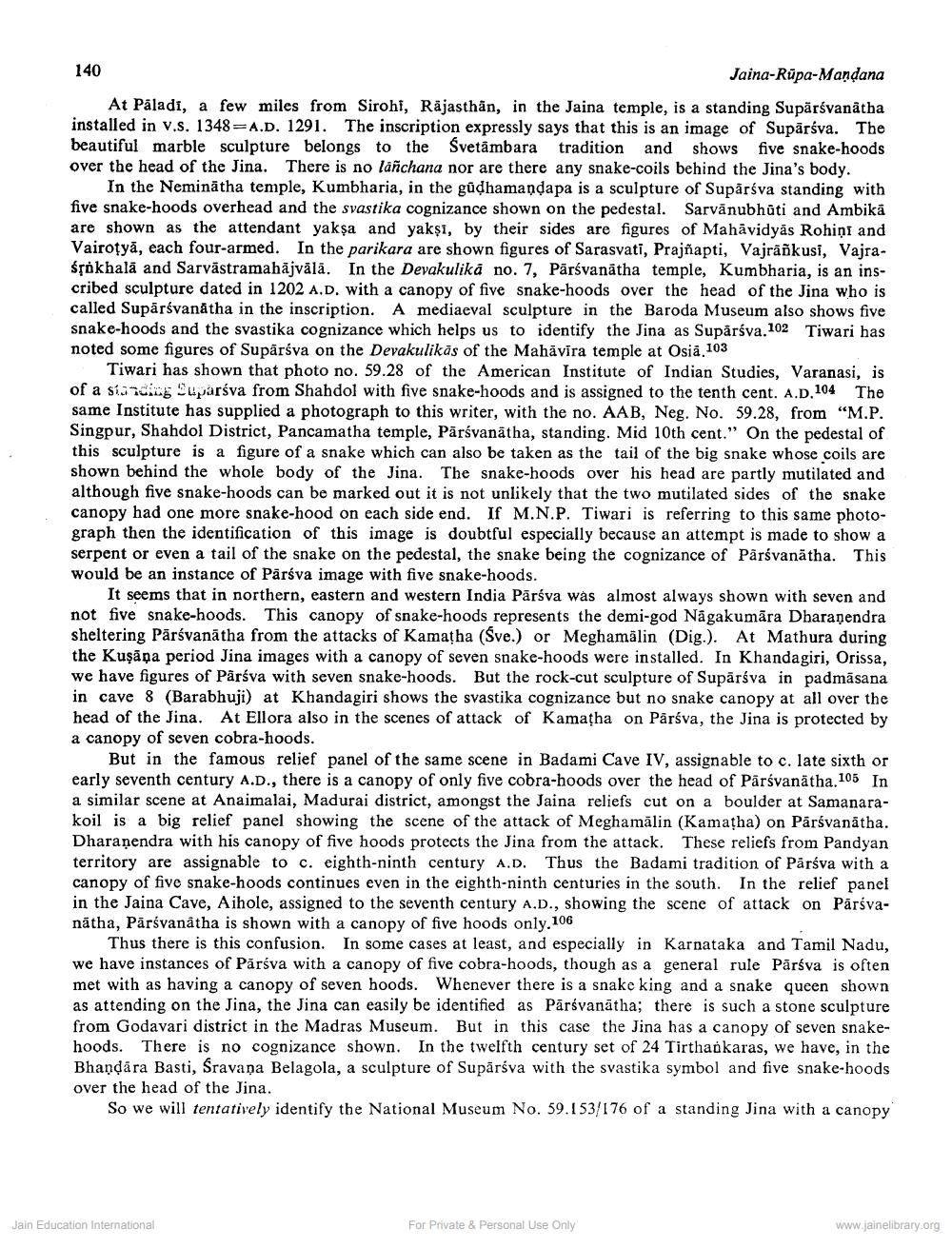________________
140
Jaina-Rupa-Mandana At Paladi, a few miles from Sirohi, Rajasthan, in the Jaina temple, is a standing Supārsvanatha installed in v.s. 1348 = A.D. 1291. The inscription expressly says that this is an image of Supärśva. The beautiful marble sculpture belongs to the Svetambara tradition and shows five snake-hoods over the head of the Jina. There is no lañchana nor are there any snake-coils behind the Jina's body.
In the Neminātha temple, Kumbharia, in the gūdhamandapa is a sculpture of Supärśva standing with five snake-hoods overhead and the svastika cognizance shown on the pedestal. Sarvānubhùti and Ambikä are shown as the attendant yakşa and yaksi, by their sides are figures of Mahavidyas Rohiņi and Vairotyā, each four-armed. In the parikara are shown figures of Sarasvati, Prajñapti, Vajränkusi, Vajraśșókhalā and Sarvästramahājvālā. In the Devakulikā no. 7, Pärśvanātha temple, Kumbharia, is an inscribed sculpture dated in 1202 A.D. with a canopy of five snake-hoods over the head of the Jina who is called Supārsvanātha in the inscription. A mediaeval sculpture in the Baroda Museum also shows five snake-hoods and the svastika cognizance which helps us to identify the Jina as Supärśva.102 Tiwari has noted some figures of Supārsva on the Devakulikās of the Mahāvīra temple at Osia.103
Tiwari has shown that photo no. 59.28 of the American Institute of Indian Studies, Varanasi, is of a sis adise Suparsva from Shahdol with five snake-hoods and is assigned to the tenth cent. A.D. 104 The same Institute has supplied a photograph to this writer, with the no. AAB, Neg. No. 59.28, from "M.P. Singpur, Shahdol District, Pancamatha temple, Pārsvanātha, standing. Mid 10th cent." On the pedestal of this sculpture is a figure of a snake which can also be taken as the tail of the big snake whose coils are shown behind the whole body of the Jina. The snake-hoods over his head are partly mutilated and although five snake-hoods can be marked out it is not unlikely that the two mutilated sides of the snake canopy had one more snake-hood on each side end. If M.N.P. Tiwari is referring to this same photograph then the identification of this image is doubtful especially because an attempt is made to show a serpent or even a tail of the snake on the pedestal, the snake being the cognizance of Pärsvanätha. This would be an instance of Pārsva image with five snake-hoods.
It seems that in northern, eastern and western India Pārsva was almost always shown with seven and not five snake-hoods. This canopy of snake-hoods represents the demi-god Nágakumāra Dharanendra sheltering Pärśvanātha from the attacks of Kamatha (Sve.) or Meghamälin (Dig.). At Mathura during the Kuşāņa period Jina images with a canopy of seven snake-hoods were installed. In Khandagiri, Orissa, we have figures of Päráva with seven snake-hoods. But the rock-cut sculpture of Supärśva in padmāsana in cave 8 (Barabhuji) at Khandagiri shows the svastika cognizance but no snake canopy at all over the head of the Jina. At Ellora also in the scenes of attack of Kamatha on Parśva, the Jina is protected by a canopy of seven cobra-hoods.
But in the famous relief panel of the same scene in Badami Cave IV, assignable to c. late sixth or early seventh century A.D., there is a canopy of only five cobra-hoods over the head of Pārsvanätha. 105 In a similar scene at Anaimalai, Madurai district, amongst the Jaina reliefs cut on a boulder at Samanarakoil is a big relief panel showing the scene of the attack of Meghamālin (Kamatha) on Pärśvanātha. Dharanendra with his canopy of five hoods protects the Jina from the attack. These reliefs from Pandyan territory are assignable to c. eighth-ninth century A.D. Thus the Badami tradition of Parśva with a canopy of five snake-hoods continues even in the eighth-ninth centuries in the south. In the relief panel in the Jaina Cave, Aihole, assigned to the seventh century A.D., showing the scene of attack on Pārsvanätha, Pārsvanātha is shown with a canopy of five hoods only.106
Thus there is this confusion. In some cases at least, and especially in Karnataka and Tamil Nadu, we have instances of Parśva with a canopy of five cobra-hoods, though as a general rule Pārsva is often met with as having a canopy of seven hoods. Whenever there is a snake king and a snake queen shown as attending on the Jina, the Jina can easily be identified as Pārsvanātha; there is such a stone sculpture from Godavari district in the Madras Museum. But in this case the Jina has a canopy of seven snakehoods. There is no cognizance shown. In the twelfth century set of 24 Tirthaó karas, we have, in the Bhandara Basti, Sravana Belagola, a sculpture of Supārsva with the svastika symbol and five snake-hoods over the head of the Jina.
So we will tentatively identify the National Museum No. 59.153/176 of a standing Jina with a canopy
Jain Education International
For Private & Personal Use Only
www.jainelibrary.org




